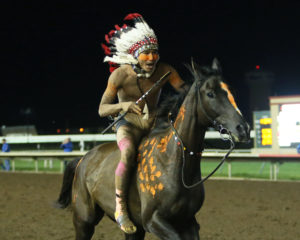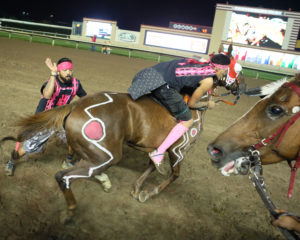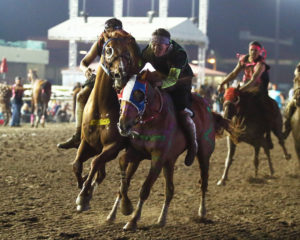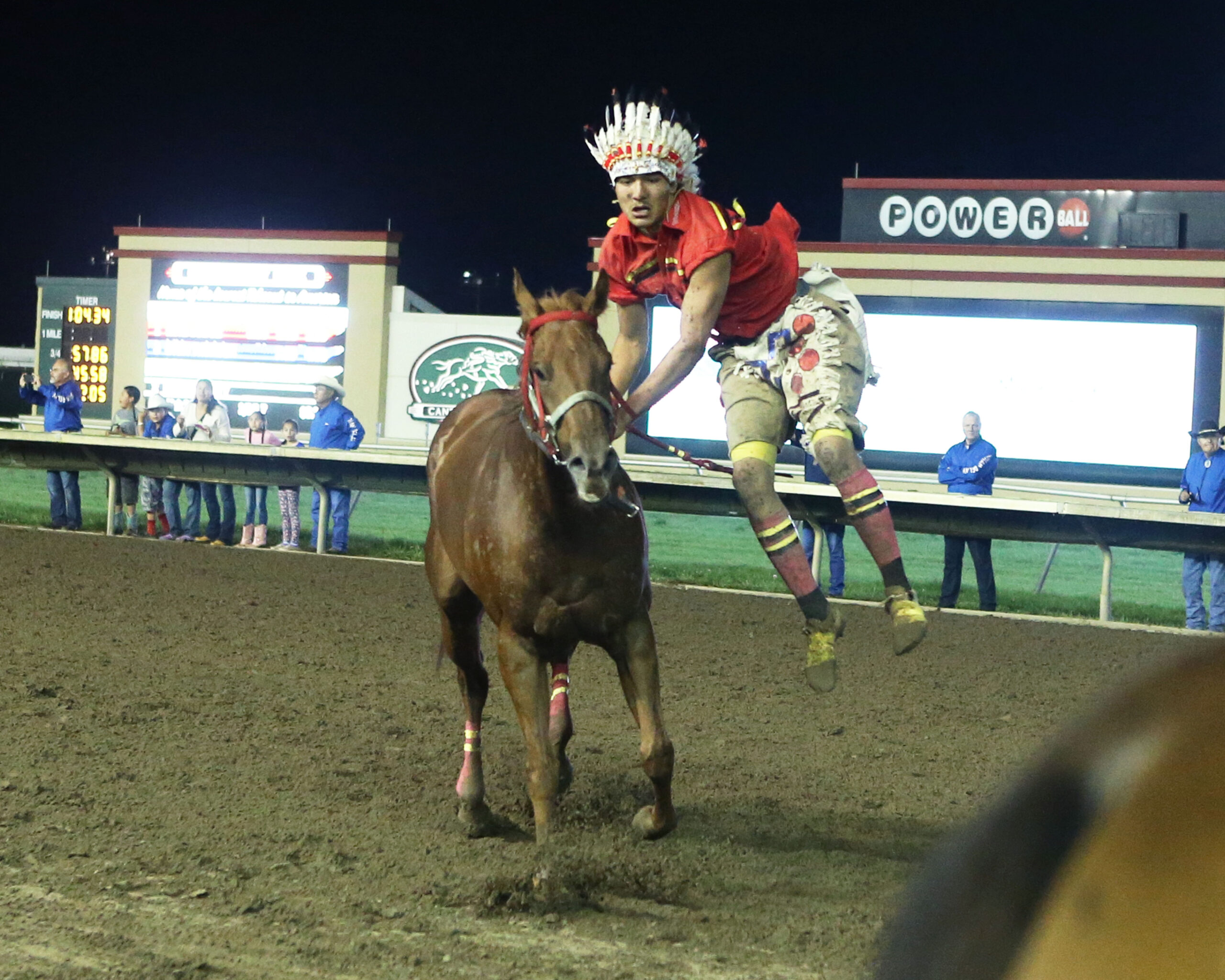Indian Horse Relay, presented by the Shakopee Mdewakanton Sioux Community (SMSC), runs from Thursday, Aug. 22 through Saturday, Aug. 24, 2019.
The event features impressive displays of horsemanship in a tradition that spans back hundreds of years.
Canterbury Park asked SMSC member Andy Vig about the event and its roots in Native culture.
Canterbury Park: What is the history of Indian Horse Relay within the culture?
 Andy Vig: The history of Indian Horse Relay goes back to the introduction of the horse into Native culture hundreds of years ago.
Andy Vig: The history of Indian Horse Relay goes back to the introduction of the horse into Native culture hundreds of years ago.
Over the years, the racing has become more contemporary but the culture is still alive and well. Racing was done in more of a day-to-day part of life in history. Today, it serves as a great piece of Native American culture. There is countless history with the horse–too long to list!
CP: How did it become an event at Canterbury?
AV: This event has a very interesting story… one of those “meant to be” scenarios.
Six years ago the SMSC met with the Crow tribe in Montana. The SMSC was involved with an economic opportunity with the Crow tribe and they invited us out to watch the horse races. A family friend thought that Indian relay racing could be something that could possibly work well at Canterbury Park. The SMSC leaders and myself flew out to Montana and watched Indian relay races at their annual Crow Native Days. We thought it was amazing and action-packed.
We then approached Canterbury Park CEO Randy Sampson and asked if it was something he would consider. He said that it sounded like a great idea and the rest is history. The timing of this event came nearly at the same time that Canterbury Park and the SMSC went into a partnership marketing deal that would help with larger purses and a joint marketing agreement with the SMSC and Mystic Lake Casino Hotel.
Although we first saw the relays at Crow (live), we quickly realized that the sport of Indian relay spans across many states and tribal nations across the Great Plains and the U.S. It has been a very positive event, not only in terms of helping grow the relationship with the SMSC and Canterbury Park, but it has also helped grow the sport of Indian relay across the country.
CP: How do you find riders?
AV: There are many ways that we find riders. In most cases we will contact team captains or team owners and ask them if they are interested in attending the event at Canterbury Park.
Team captains or owners typically own the horses and take care of all of the many details and responsibilities of running a team. It’s truly a team sport and everyone pitches in (in many cases, it’s a family thing).
The riders have a great responsibility for every team. Riders typically stay with their family team  or a team in general for many years. They build the necessary consistency and training that goes into the sport. In some cases the rider “owns” or manages their own team. What we look for are some of the best teams year to year and try and invite a wide variety of Tribal nations.
or a team in general for many years. They build the necessary consistency and training that goes into the sport. In some cases the rider “owns” or manages their own team. What we look for are some of the best teams year to year and try and invite a wide variety of Tribal nations.
CP: How do the riders prepare?
AV: The riders and teams practice and train year-round. The riders in particular are in tremendous athletic shape.
If you watch them they have tremendous verticals jumping a few feet off the ground to get onto the horses in a very fast exchange. Also, their core strength is out of this world. They basically hold onto the horses using their legs and abdomen strength as they ride around the track with no saddle. Very difficult.
The teams spend countless hours training their horse to perform to the highest level of competition. They specifically train them to stand still and content while waiting for the incoming horse.
The other main part of training is coming in at high rates of speed, putting on the brakes, and making a clean exchange handing their incoming horse to their teammate and jumping onto the next horse in the blink of an eye. The goal is to have the rider’s two feet touch the ground (one of the rules) and hop on the next horse facing in the right direction to make a clean get away.
CP: How much harder is it to ride a horse without a saddle?
AV: Extremely. I personally haven’t tried bareback myself but I have heard multiple horsemen comment on the athleticism that it takes to race bareback.
If you ask the Indian relay riders, many of them prefer it. I think they find a physical balance and connection with the horse that a saddle doesn’t allow.
CP: Where do the horses come from? Do they get trained before the races, somewhat like racehorses?
 AV: In most cases the horses are not too different than any other racehorse at any other track. In fact, one very positive thing that has come out of the Canterbury Park Indian relay event is that many teams purchase great racehorses that are looking for another racing career.
AV: In most cases the horses are not too different than any other racehorse at any other track. In fact, one very positive thing that has come out of the Canterbury Park Indian relay event is that many teams purchase great racehorses that are looking for another racing career.
Every team is always looking to purchase the next fast horse that they can get. Many of the teams also have many horses at their homes. It’s really not that different than regular horse racing. They get trained and taken care of just like any other racehorse.
The more time they spend training and taking care of their horses, the better the outcome. Training is something that every team takes very seriously.
CP: Anything else that’s interesting for people to know?
AV: I would like the general public and the fans to know that this sport is deeply rooted in the culture of the plains tribal nations and across the U.S.
Although this is a fairly new event over at Canterbury Park, tribes have been doing this kind of racing since the inception of the horse in North America. Native Americans have had a special bond with horses for hundreds of years. This is a great example of how we view other animal and plant nations on this earth.
The horses are living and we respect and value all living things. Which is everything. Mitakuye Owasin (we are all related).
There are many songs, stories, and cultural significance associated with the horse. They have always helped us and continue to do so. For that we are forever grateful to our Brother the horse. Sunka Wakan Oyate (The Horse Nation).
